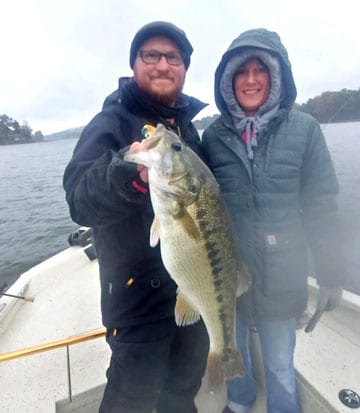As cooler weather has settled in and the leaves have almost all fallen off, some of the most intense and productive fishing of the year has finally arrived: winter smallmouth and spotted bass fishing. While I love the pursuit of stripers, smallmouth, walleye, crappie, trout, and pretty much everything else that swims in our area lakes (and am more than happy to guide for them in the winter months), I do tend to prefer focusing on smallmouth and spotted bass in the December-February timeframe, and for good reason.
Winter is big fish time when it comes to spots and smallmouth. I have been blessed to have had hundreds of clients catch their personal best smallmouth and spotted bass with me over the last few years, and the biggest of those have tended to come in the winter months. Another major advantage to fishing this time of year is that the fish tend to congregate in large schools, and it is not unheard of to have 40 and 50 fish days. A final advantage, at least from a guiding perspective, is that cooler water temperatures translate to less fish movement, which effectively means that once you find the fish you can then expect them to remain in the same general area for weeks or even months at a time.
Weather, specifically its effect on water temperature and clarity, are the determining factors in where to look for fish, and in what baits to use to catch them. Clear, cold water often means that fish set up deeper and suspend more, usually on the main channel or partially into the bigger tributary creeks. I will generally start looking for them in 18-25 feet of water, but I am not afraid to fish all the way out into 60 or 70 feet if that is where the bait is. This is when good electronics are an absolute must. I start looking for fish on points, but not all points are created equal. I prefer a point with a good bit of flat area, then a sudden drop. Fish are often at the base of that drop, and I think they use it as an ambush point for passing bait. I also particularly like areas where creek channels intersect a point, and don’t ever discount the holding potential of a creek channel bend or good, deep brushpile. Other areas to search, especially for spots, are sunken roadbeds, house foundations, and old underwater culverts.
If the water is slightly stained, the fish will still use similar areas, but will often slide shallower, especially later in the day if there is ample warm sunshine to raise the water temperature in the upper part of the water column. However, even though the fish will move shallower, they don’t necessarily go to the bank. Instead, they will often suspend 6-10 feet deep over much deeper water. If the water is heavily stained, or even muddy, fish will tend to flood the banks, especially if the source of the stain is rain that is substantially warmer than the water temperature. These fish will usually be anywhere from ankle deep out to about 8 feet, but the 4 to 6 foot range seems to hold the most active fish.
Cold weather is here to stay, but don’t let that keep you from experiencing some of the best fishing of the year, and potentially of your life. Most of the best days for winter fishing are somewhat mild weather wise, and if you layer appropriately you may even find that you are quite comfortable. If you come down with a sudden case of cabin fever and want to chase some brown beauties or giant spots with me give me a call at 865-466-1345. Also, if you want to purchase a trip for someone special on your Christmas list I am selling gift certificates. I look forward to hearing from you, and Merry Christmas!
Aaron Kephart is the Owner of Mountain Lakes Guide Service. To book a guided trip on one of the Murphy area mountain lakes, contact him by phone or by email at mtnlakesguide@outlook.com Check out his website at www.mtnlakesguideservice.com and catch him on facebook@mountainlakesguideservice
